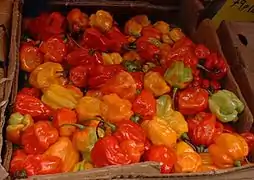Scotch bonnet
Scotch bonnet, also known as bonney peppers, or Caribbean red peppers,[1] is a variety of chili pepper named for its resemblance to a tam o' shanter hat.[2][3] It is ubiquitous in West Africa.[4] Most Scotch bonnets have a heat rating of 100,000–350,000 Scoville units.[5] For comparison, most jalapeño peppers have a heat rating of 2,500 to 8,000 on the Scoville scale. However, completely sweet varieties of Scotch bonnet called cachucha peppers are grown on some of the Caribbean islands.
| Scotch bonnet | |
|---|---|
 | |
| Species | Capsicum chinense |
| Cultivar | 'Scotch Bonnet' |
| Heat | |
| Scoville scale | 100,000–350,000 SHU |
These peppers are used to flavor many different dishes and cuisines worldwide and are often used in hot sauces and condiments. The Scotch bonnet has a sweeter flavor and stouter shape, distinct from its habanero relative with which it is often confused, and gives jerk dishes (pork/chicken) and other Caribbean dishes their unique flavor. Scotch bonnets are mostly used in Maldivian, West African, Antiguan, Kittitian/Nevisian, Anguilan, Dominican, St. Lucian, Martinican, Guadeloupean, St Vincentian, Grenadian, Trinidadian, Jamaican, Barbadian, Guyanese, Surinamese, Haitian and Cayman cuisines and pepper sauces, though they often show up in other Caribbean recipes. It is also used in Nicaragua, Costa Rica and Panama for Caribbean-styled recipes such as rice and beans, rondón, saus, beef patties, and ceviche. Scotch bonnet is also prominent in the cuisine of the Maldives where it is called githeyo mirus.
Fresh, ripe Scotch bonnets can change from green to yellow to scarlet red; some varieties of this pepper can ripen to orange, yellow, peach, or even a chocolate brown.
 Scotch bonnet peppers in a Caribbean market
Scotch bonnet peppers in a Caribbean market A single ripe Scotch bonnet pepper
A single ripe Scotch bonnet pepper
See also
References
- "Chili Peppers Recipes".
- DeWitt, Dave (1996). Pepper Profile: Scotch Bonnet. Fiery-Foods.com.
- Andrews, Jean (1998). The Pepper Lady's Pocket Pepper Primer. University of Texas Press. p. 147. ISBN 978-0-292-70483-1.
- "Mead Recipes: Scotch Bonnet Capsimel".
This recipe uses very hot Scotch Bonnet chilies (which are ubiquitous in West Africa).
- "Hot Chili Peppers on the Scoville Scale: Measuring chili pepper heat in Scoville units". The Spruce Eats. The Spruce. Archived from the original on 29 May 2018. Retrieved 2008-08-21.
External links
 Media related to Scotch Bonnet at Wikimedia Commons
Media related to Scotch Bonnet at Wikimedia Commons